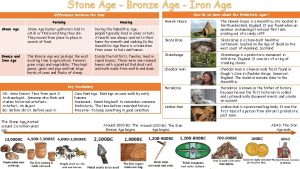Iron Age Hillforts In the Iron Age the








- Slides: 8

Iron Age Hillforts

In the Iron Age the land was ruled over by tribes who built Hillforts, so they could be safe from other tribes and see across the land that surrounded them. They could be defended against attackers and provided shelter for the tribe. They could be small with just a few people or very large, home to several hundred people. A 1979 survey identified 3, 840 sites around the UK.

How were they defended? Hillforts were built to be easily defended from other tribes. They were built in such a way that any attacker would need to climb one or several, steep banks and ditches before they even got to the 3 m high stone ramparts, topped with a wooden wall or palisade (pictured below). Wooden palisade How the ground looks today Steep bank stone ramparts Ditch

The defenders would also have weapons to defend the hillfort. Very common was the sling (picture above). A sling was used to fire a pebble or stone at an enemy. It was cheap and easy to make from rope or leather and was deadly up to about 60 meters though they could travel over 200 metres. Sling-stones could rain down on attackers like artillery fire. At Maiden Castle one archaeologist discovered 22, 000 sling-stones in a pit ready to defend the hillfort.

Northumberland’s Hillforts Fenced off areas for animals and crops such as vegetables. Roundhouses • Iron Age hillforts in Northumberland are extraordinarily well preserved, rivalling anything to be found elsewhere in Europe. • Most have been left relatively untouched since they were last occupied, in the Iron Age, around 1, 500 years ago. • The Iron Age workforce built these structures with antler picks and wooden spades, using baskets to transfer the rubble and soil. The average hillfort would take 200 men at least 100 days to construct. • This picture shows what they would have looked like. A defensive outer wall and ditch system with round houses built for the tribespeople. Entrance with guards Wooden palisade banks and ditches

There are hundreds of Hillforts sites in Northumberland. Every dot on this map is where a hillfort used to be! Newcastle

Lordenshaws Hillfort, Rothbury, Northumberland. You can see the remains of the ditches and banks on this aerial photograph.

Task Use the information found in this Power. Point to create a leaflet about Iron Age Hillforts which could be available at museums. Include a heading and subheadings. Include the following details. § When they were used § Who built them and how. Leaflet example. 1 side of A 4 size. § Where are they and how many are there? § How were they defended? § Include a diagram to show the banks, ditches and walls. § Include accurate statistics which would include dates, amounts and facts.















